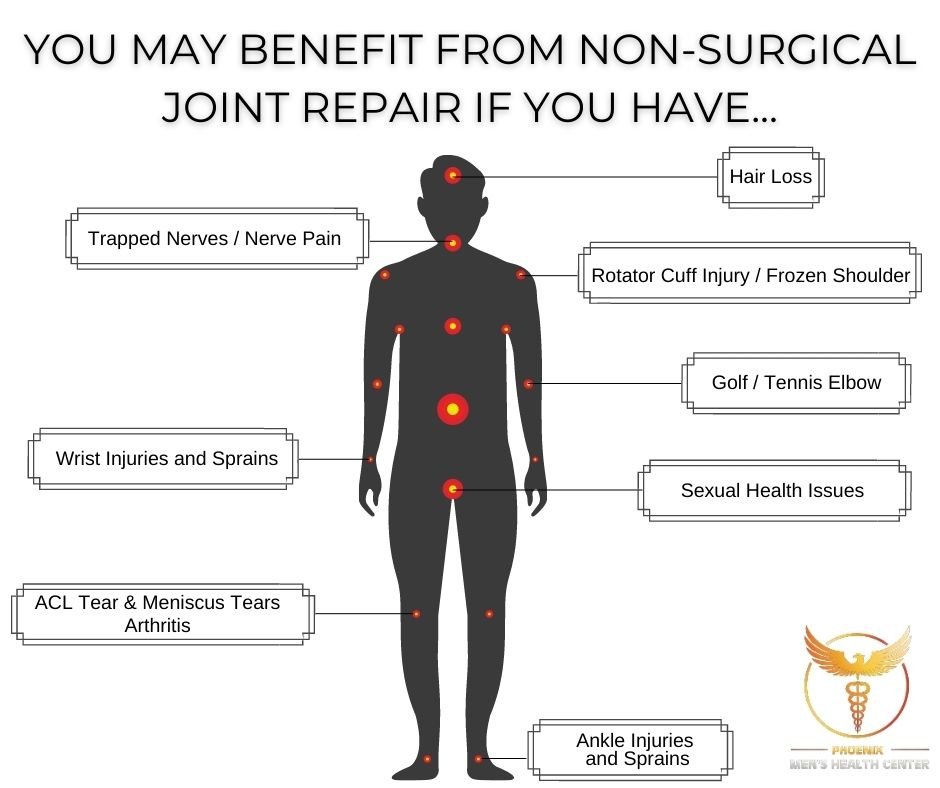NON-SURGICAL
JOINT REPAIR
WHAT IS NON-SURGICAL JOINT REPAIR?
Non-Surgical Orthopedic procedures for chronic pain, injury and arthritis, influence your body’s natural healing response to regain mobility quickly and without invasive surgery. These regenerative treatments eliminate the need for opioids and other potentially addictive pharmaceuticals. Even when other healthcare providers have exhausted all options, even if they have tried physical therapy, or other injections therapies, such as cortisone, but have not seen the results, Now there is hope for you! These Regenerative Medicine treatments at PMHC are making a huge impact with patients just like you. Even if you have been told you need surgery, it’s not too late, there is a good possibility that you could avoid such surgical procedures. Yes, there are logical times when surgery is the correct option, but it should be the last option.
Experience PMHC’s award-winning care, our unique approach focuses on innovation, optimization and integrative treatments that have propelled PMHC in redefining healthcare.
THE REGENERATIVE LIFESTYLE
There is a preparation phase for regenerative treatments. Experienced regenerative physicians share a common philosophy which focuses on nutrition, stress management, movement exercises, and functional medicine. Inflammation can be triggered by a poor diet, stress, improper movement patterns, by genetics, by an imbalance of hormones, or by an insufficient digestive response. If these areas of inflammation are addressed first, then the success rate increases significantly. In some cases, regenerative treatments are not even needed once the inflammation is controlled. Managing these lifestyle habits are important to the overall regenerative response.
PATIENT JOHN TELLS ABOUT HIS SHOULDER PROCEDURE
We offer a FREE 15 Minute Consultation
Wondering if you should do non-surgical joint repair procedures?
REGENERATIVE MEDICINE OR CELL THERAPY

PRP, Prolotherapy and Amniotic Fluid is the power-cell behind the regeneration of tissue and uses healthy growth factors as a building block in an attempt to mimic other damaged cells located in the joint. Dr. Molina saw the promising effects of what PRP and Amnitotic Fluids could do to promote healing and repair and decided to offer this non-invasive procedure. Though these procedures cannot guarantee results for all, there have been many studies done that are proving the results are effective and worthy of practicing. The research is continuing to explode as many leading experts are seeing incredible results with these procedures. PMHC continues to strive in pioneering the field of Regenerative Medicine. As you can see, there are many success stories that have poured out of this clinic over the past 10-years.
Non-surgical treatments have been shown to be effective modalities for patients who:
are restricted from performing common tasks due to stiff joints and pain
suffer from chronic pain on a daily basis
are trying to return to a sport quickly following an acute injury
have recent or past acute injuries and are looking for quick recovery
have failed to get results from other treatment options offered
are exploring alternative options to surgery
want to move better and feel better
You May Benefit From Orthopedic Regenerative Therapy If You Have:
Avascular Necrosis
Bone Loss
Cartilage Defects
Degenerative Joint Changes, Including Osteoarthritis
Disc-related Back Pain
Meniscus Tears
Non-Union Fractures
Osteonecrosis
Tendonopathies
Do you qualify for non-surgical joint repair?
Are you experiencing any of the ailments mentioned above? Find out if you qualify for non-surgical joint repair.
PRP or Platelet Rich Plasma Treatments
Platelet Rich Plasma Has Been Helpful In Treating:
Tendonitis / Tendonosis
Lower Back Pain
Chronic Sprains and Strains
Lower Back Pain
Osteoarthritis Pain
Rotator Cuff Partial Tears
Neck Pain
Bursitis
Whiplash Injuries
Plantar Fasciitis
PRP FAQs
Prolotherapy
Prolotherapy FAQs
Amniotic Fluid
Amniotic fluid
Contains a high concentration of stem cells.
Contains no steroids. Instead they rely on naturally occurring anti-inflammatory agents such as cytokines.
Contains hyaluronic acid which lubricates the joints and promotes healing. Hyaluronic acid is the main component of Synvisc and Hyalgan that are commonly used today in injections of knee joints. Unfortunately they do not work very well by themselves.
Contains more than 10 times the concentration of growth factors than platelet rich plasma that stimulates cellular growth and healing of bone, muscle, cartilage, ligaments, and tendons
Michelle Shares Her Patient Story
Comparison of Non-Surgical Joint Repair Procedures
| AMNIO | PRP | PROLOTHERAPY | OZONE | |
|---|---|---|---|---|
|
Cost
|
AMNIO
$$$$
|
PRP
$$$
|
PROLOTHERAPY
$$
|
OZONE
$$
|
|
Treatments Required
|
AMNIO
1-2
|
PRP
2-4
|
PROLOTHERAPY
2-4
|
OZONE
2-4
|
|
Type of Injury
|
AMNIO
Severe, Moderate
|
PRP
Moderate, Mild
|
PROLOTHERAPY
Mild
|
OZONE
Mild
|
|
Strength of Treatment
|
AMNIO
Strongest
|
PRP
Stronger
|
PROLOTHERAPY
Strong
|
OZONE
Mild
|
|
Shoulder
|
AMNIO
|
PRP
|
PROLOTHERAPY
|
OZONE
|
|
Elbow
|
AMNIO
|
PRP
|
PROLOTHERAPY
|
OZONE
|
|
Knees
|
AMNIO
|
PRP
|
PROLOTHERAPY
|
OZONE
|
|
Ankles
|
AMNIO
|
PRP
|
PROLOTHERAPY
|
OZONE
|
|
Lower Back
|
AMNIO
|
PRP
|
PROLOTHERAPY
|
OZONE
|
|
Hip
|
AMNIO
|
PRP
|
PROLOTHERAPY
|
OZONE
|
|
Sexual
|
AMNIO
|
PRP
|
PROLOTHERAPY
|
OZONE
|

